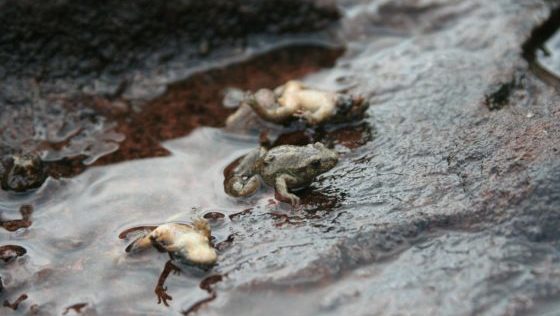
TRUMP SAYS: HUNTER MAKES FORTUNE FROM SHADY DEALS!
BIDEN FAMILY STINKS TO HIGH HEAVENS OF CORRUPTION!
DON'T GET LEFT OUT: HUNTER MUST BE STOPPED!


An ancient skin-eating fungus is killing off hundreds of species of amphibians, and the source of this apocalypse was just found. Compounding the issue is the assertation that the Korean War may have helped amplify the problem and spread the fungus.
Since the 1970s, the aquatic fungus Batrachochytrium dendrobatidis has triggered die-offs in hundreds of amphibian species such as the common midwife toad (Alytes obstetricans), according to National Geographic.
This is a big deal for the balance of life on Earth, and no one says it quite as eloquently as James Woods via Twitter:
One of those neglected news articles viewed in retrospect years from now when people will say, “That’s when the End Times started, but we didn’t realize it at the time…” https://t.co/US1Dtegcpx
— James Woods (@RealJamesWoods) May 11, 2018
This ecological super-villain, the chytrid fungus Batrachochytrium dendrobatidis, has driven more than 200 amphibian species to extinction or near-extinction forcing the radical rewiring of ecosystems all over Earth. The fungus, called Bd for short, is so deadly because it targets amphibians’ porous skin, which the animals use to breathe and drink water. Bd unspools the skin’s proteins and feasts on the resulting spaghetti of amino acids. As it does, infected animals grow lethargic, shedding their skin in a death spiral that ends with heart failure in a matter of weeks. Some amphibians can tolerate or resist Bd, but the fungus can infect at least 695 species to varying degrees.
In person, Bd infestations can look like biblical plagues. Each August, adult midwife toads in the French Pyrenees climb out of their birth lakes for the first time. The infected toads barely make it to shore. “They’ll do one last hop, and then they’ll expire in your hands,” says Fisher, one of the study’s coauthors. “You can walk the lakes—it’s just carpets of dead frogs.”
“This is the worst pathogen in the history of the world, as far as we can tell, in terms of its impacts on biodiversity,” says Mat Fisher, an Imperial College London mycologist who studies the fungus. “This is pretty unusual for a disease, to see it affect so many different species,” says University of Maryland biologist Karen Lips, an amphibian-decline expert who wasn’t involved with the new study.
But it goes from bad to worse. A global team of 58 researchers has uncovered the creature’s origin story. A groundbreaking study published in Science on Thursday reveals where and when the fungus most likely emerged: the Korean peninsula, sometime during the 1950s. From there, scientists theorize that human activities inadvertently spread it far and wide leading to the amphibian die-offs across the Americas, Africa, Europe, and Australia.
“[The pathogen’s spread] could have happened from any one event, from the cumulative number of events, or maybe some big anthropogenic events like the Korean War,” says Imperial College London researcher Simon O’Hanlon, the study’s lead author.

It Took 22 Years to Get to This Point
The health "experts" are "on alert" after the first case of bird flu has been found in a child....
An elderly member of the Rothschild banking cartel dynasty is believed to have been killed in a...
This article was originally published by Ethan Huff at Natural News. Things are heating up on the...
Commenting Policy:
Some comments on this web site are automatically moderated through our Spam protection systems. Please be patient if your comment isn’t immediately available. We’re not trying to censor you, the system just wants to make sure you’re not a robot posting random spam.
This website thrives because of its community. While we support lively debates and understand that people get excited, frustrated or angry at times, we ask that the conversation remain civil. Racism, to include any religious affiliation, will not be tolerated on this site, including the disparagement of people in the comments section.


Ewww. Toads. Talk about a creature that looked like a Biblical plague even before it contracted an “End of Times” skin eating fungus. Ewww. Bye Bye little toadies.
https://www.bing.com/videos/search?q=george+carlin+extinction+of+life&view=detail&mid=B94E8D367785730AD406B94E8D367785730AD406&FORM=VIRE
So, in summary –
“Thanks for the millions in grant money over the years, but we still don’t have any idea what caused this.”
“[The pathogen’s spread] could have happened from any one event, from the cumulative number of events, or maybe some big anthropogenic events like the Korean War,” says Imperial College London researcher Simon O’Hanlon, the study’s lead author.>/b>
Or it could have been space dust that spread over that area and affected the whole area, or an exploding meteor.
and this is why we should be able to edit our own posts
If this could be used on libturds…..
Lol. Comment of the day winner.
Radiation burns from 137
Is it going to bring a spike in the price of frog legs?
There will be no more frogs for chemicals to turn gay !
What? No more soy frogs?
Even so, the atrazine that causes hormonal changes in the frogs will be available to affect other species.
Or it could have been caused by the chemical and biological agents dropped on Korea by the US during the war.
Frog legs are off the menu!
Stories like this are scary.
Be it known that some pervert is, at this moment, attempting to mutate the fungus into a people-killing machine.
This is where we are, wait for Bill Gates to fund the mutation research or propose a vaccine that is certain to inoculate you with live spores.
The alien amphibian overlords have been unable to adapt to Earth’s environment.
I felt that flesh eating microbes are found, wherever something has died. Death is ubiquitous. So is decomposition. And, the relationship between what is dying and what is rotting is a chicken-and-egg argument.
I believe in the words of the Christian pastor, Malthus, who was not necessarily proactive in his concept of population management. He was not a killer, himself, although he was misunderstood to promote eugenics.
If you had some lukewarm, sedentary, second world kind of atmosphere, like in Calhoun’s degenerate rat utopia experiment, where everyone has what they need, there will still be a population collapse.
Malthus said that a spontaneous emergency (not manmade) would result in an equilibrium, between the population numbers and the agricultural carrying capacity.
It doesn’t require any Machiavellian change agent for some germ, or natural cataclysm, or naughty meme to roil the mob, out of nowhere. Diplomatic people like to ask whether the little things will matter a hundred years from now. Yes, in the same respect that a Butterfly Effect triggers a hurricane. It’s not anyone’s fault, necessarily, unless you’re the kind of masochist, who likes to take the blame for everything.
Noone reading hurt those frogs, though we are being told that human agency was involved, negatively. If you had preserved them, charitably, in a zoo, or supported them, in nature, the same thing could have happened.
Did they bother to mention that it spread everywhere on The scientists who where studying the frogs clothes? That this is the fault of the scientists and eco conservatists that where to lazy to sterilize their gear between different locations? Nah we can’t say all of that now can we…